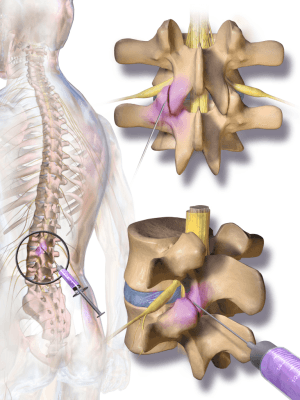What are Facet Joint Injections?
Facet joints are located on both sides of the rear of the spine. They connect each vertebra in the spine to the vertebra above and below it. The facet joints can become painful due to arthritis, injury or overexertion of the neck/back. A facet joint injection involves injecting a small quantity of numbing agent (local anesthetic) and/or steroid medication, which can anesthetize the facet joints and block the pain. A facet joint injection is mainly diagnostic – the amount of immediate pain relief experienced by the patient will help determine if the facet joint is a source of pain.
Facet joint injections, a minimally invasive procedure, decrease inflammation and irritation in the facet joints of the spine. The injected medication includes a combination of local anesthetic and long-lasting steroid. By numbing affected nerves, the numbing medication temporarily halts transmission of pain signals to the brain, and the slow-release steroid combats inflammation. When the injection is delivered around the medial branch nerves that innervate the facet joint, it is called a Medial Branch Block, or MBB.
Facet injections/MBBs can also be used as a diagnostic tool. Upon injection, disappearance of pain in the affected region confirms the origin of the pain and demonstrates the condition is treatable with facet injections. It also reveals whether a patient is likely to benefit from radiofrequency ablation, a more permanent treatment that uses an electric current from a radio wave to cauterize affected nerves, thereby decreasing pain signals from the affected area.
Facet Joints
The vertebrae of the spine interact, or articulate, smoothly with each other at joints located between and behind the vertebrae. Called facet joints, these structures are comprised of articular and transverse processes. The articular processes of a vertebra are comprised of two superior (upwardly pointing) processes that connect with two inferior (downwardly pointing) processes supplied by the preceding vertebral body. These processes project outward and can be felt through the skin on some people. The transverse processes are located on either side of each vertebra and serve as attachment points for muscles and ligaments.
Facet joints stabilize the spine, preventing excessive motion in all directions. They provide necessary limits to rotation and prevent forward slippage of vertebrae over each other (spondylolithesis). Without facet joints, the spine would move in a loose and unlimited fashion, which could damage the spinal cord and adjacent nerves, compromising the overall musculoskeletal stability of the body.
The interacting surfaces of each facet joint are protected by smooth cartilage and lubricated by a special fluid, which together combat friction in the joint. Since facet joints are in almost continual use, wear and tear on sliding surfaces may promote the development of painful conditions. For example, erosion of the cartilage in facet joints may cause involved bone to enlarge and produce bone spurs (osteophytes), or sharp projections along the bone that inhibit movement and cause pain. Such degenerative changes in facet joint bone represent the onset of facet joint arthritis, which can produce chronic back pain. Another complication of facet joint overuse is inflammation, which may cause associated muscles to go into painful spasm.
Symptoms
Generally, patients with facet joint problems experience intermittent, unpredictable episodes of cervical and lumbar back pain which may worsen upon leaning backwards. In addition, most of these patients report tenderness directly over irritated facet joints as well as limitations in spinal range of motion (guarding).
When facet pain occurs in the low back, it often radiates down into the buttocks and back of the upper leg. Likewise, pain in the cervical (neck) facet joints may radiate into the back of the head, the shoulders, upper back, or into the upper arm.

Conditions Treated with Facet Joint Injections
Conditions commonly treated with facet injections/MBBs include:
- Cervical Spondylolysis,
- Thoracic Spondylosis
- Lumbar Spondylosis
- Facet Joint Osteoarthritis
- Spine Arthritis
- Neck Pain
- Mid-back Pain
- Low Back Pain
- Sacroiliac Pain
- Certain Headaches
Efficacy of Facet Joint Injections
Patients who receive facet injections/MBBs report rapid relief of symptoms. Often, they are able to resume their normal level of activity immediately.
The efficacy of facet joint injections is supported by many recent studies. For example, researchers who conducted a two-year review of literature concluded that controlled comparative local anesthetic blocks of facet joints (medial branch or dorsal ramus) are reproducible, reasonably accurate and safe (Sehgal, 2007). And a Swiss study on patients with chronic lower back pain who were receiving facet injections concluded the treatment appeared to have a beneficial medium-term effect in one-third of patients with chronic lower back pain and may therefore be a reasonable adjunct to nonoperative treatment (Gorbach, 2006).
Wake Spine & Pain Specialists understands the stress and inconvenience of living with a painful condition and strives to bring you back to health as quickly, efficiently and non-invasively as possible. With our numerous combined years of experience, we are confident we can design the best pain management plan for you.
Sources
- Gorbach, C. (2006). Therapeutic efficacy of facet joint blocks. AJR Am J Roentgenol, 186(5), Retrieved from http://www.ncbi.nlm.nih.gov/pubmed/16632710
- Hildebrandt, J. (2001). [relevance of nerve blocks in treating and diagnosing low back pain–is the quality decisive?]. Schmerz, 15(6), Retrieved fromhttp://www.ncbi.nlm.nih.gov/pubmed/11793154
- Sehgal, N, et al. (2007). Systematic review of diagnostic utility of facet (zygapophysial) joint injections in chronic spinal pain: an update. Pain Physician, 10(1), Retrieved fromhttp://www.ncbi.nlm.nih.gov/pubmed/17256031


